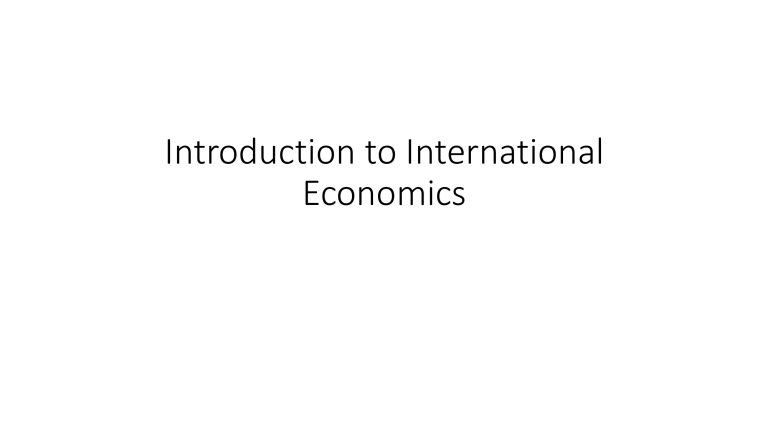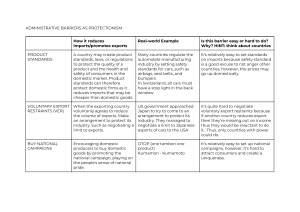
Introduction to International Economics Introduction • International economics is about how nations interact through trade of goods and services, through flows of money and through investment. • International economics is growing in importance as a field of study because of the rapid integration of international economic markets. Increasingly, businesses, consumers, and governments realize that their lives are affected not only by what goes on in their own town, state, or country but also by what is happening around the world. • The growth of international trade and investment has been stimulated partly by the steady decline of trade barriers since the Great Depression of the 1930s. In the post–World War II era, the General Agreement on Tariffs and Trade, or GATT, prompted regular negotiations among a growing body of members to reciprocally reduce tariffs (import taxes) on imported goods. • Another international push for trade liberalization has come in the form of regional free trade agreements. International trade and International Finance • International trade focuses on transactions of real goods and services across nations. • These transactions usually involve a physical movement of goods or a commitment of tangible resources like labor services. • International finance focuses on financial or monetary transactions across nations. For example, purchases of US dollars or financial assets by Indians. • International trade is a field in economics that applies microeconomic models to help understand the international economy. Its content includes basic supply-and demand analysis of international markets; firm and consumer behavior; perfectly competitive, oligopolistic, and monopolistic market structures; and the effects of market distortions. The typical course describes economic relationships among consumers, firms, factory owners, and the government. • International finance applies macroeconomic models to help understand the international economy. Its focus is on the interrelationships among aggregate economic variables such as GDP, unemployment rates, inflation rates, trade balances, exchange rates, interest rates, and so on. This field expands basic macroeconomics to include international exchanges. Its focus is on the significance of trade imbalances, the determinants of exchange rates, and the aggregate effects of government monetary and fiscal policies. The pros and cons of fixed versus floating exchange rate systems are among the important issues addressed. World exports (as per cent of world GDP) World Inward FDI India’s exports as per cent of GDP Patterns of Trade • Differences in climate and resources can explain why Brazil exports coffee and Australia exports iron ore. • But why does Japan export automobiles, while the US exports aircraft? Differences in labor productivity may explain why some countries export certain products. • How relative supplies of capital, labor and land are used in the production of different goods may also explain why some countries export certain products. Determinants of international trade • Size- Larger economies produce more goods and services, so they have more to sell in the export market. Larger economies generate more income from the goods and services sold, so people are able to buy more imports. • Distance between markets influences transportation costs and therefore the cost of imports and exports. Distance may also influence personal contact and communication, which may influence trade. • Cultural affinity: if two countries have cultural ties, it is likely that they also have strong economic ties. • Geography: ocean harbors and a lack of mountain barriers make transportation and trade easier. • Multinational corporations: corporations spread across different nations import and export many goods between their divisions. • Borders: crossing borders involves formalities that take time and perhaps monetary costs like tariffs. These implicit and explicit costs reduce trade. The existence of borders may also indicate the existence of different languages or different currencies, either of which may impede trade more. The Effects of Government Policies on Trade • Policy makers affect the amount of trade through tariffs: a tax on imports or exports, quotas: a quantity restriction on imports or exports, export subsidies: a payment to producers that export, or through other regulations (e.g., product specifications) that exclude foreign products from the market, but still allow domestic products. • Relevant questions- which policy to use, how much to restrict, what if foreign governments respond likewise? Gravity Model • The gravity model, first introduced by Walter Isard, assumes that only size and distance are important for trade in the following way: Tij = A x Yi x Yj /Dij where Tij is the value of trade between country i and country j A is a constant Yi the GDP of country i, Yj is the GDP of country j Dij is the distance between country i and country j Estimates of the effect of distance from the gravity model predict that a 1% increase in the distance between countries is associated with a decrease in the volume of trade of 0.7% to 1%. • The negative effect of distance on trade according to the gravity models is significant, but it has grown smaller over time due to modern transportation and communication. • But history has shown that political factors, such as wars, can change trade patterns much more than innovations in transportation and communication. • Today, most of the volume of trade is in manufactured products such as automobiles, computers, clothing and machinery. • Services such as shipping, insurance, legal fees and spending by tourists account for 20% of the volume of trade. • Mineral products (e.g. petroleum, coal, copper) and agricultural products are a relatively small part of trade. Composition of world trade Changing composition of developing country exports Outsourcing • Outsourcing occurs when a firm moves business operations out of the domestic country. The operations could be run by a subsidiary of a multinational corporation. Or they could be subcontracted to a foreign firm. • Outsourcing of either type increases the amount of trade. Global Value Chains-International production, trade and investments are increasingly organized within so-called global value chains (GVCs) where the different stages of the production process are located across different countries. Globalization motivates companies to restructure their operations internationally through outsourcing and offshoring of activities. The past decades have witnessed a strong trend towards the international dispersion of value chain activities such as design, production, marketing, distribution, etc. Gains from Trade • When a buyer and a seller engage in a voluntary transaction, both receive something that they want and both can be made better off. • With a finite amount of resources, countries can use those resources to produce what they are most productive at (compared to their other production choices), then trade those products for goods and services that they want to consume. • Countries can specialize in production, while consuming many goods and services through trade. • Trade is predicted to benefit a country by making it more efficient when it exports goods which use abundant resources and imports goods which use scarce resources. • When countries specialize, they may also be more efficient due to large scale production. • Countries may also gain by trading current resources for future resources (lending and borrowing). • Trade is predicted to benefit countries as a whole in several ways, but trade may harm particular groups within a country. • International trade can adversely affect the owners of resources that are used intensively in industries that compete with imports. • Trade may therefore have effects on the distribution of income within a country. • Conflicts about trade should occur between groups within countries rather than between countries.





